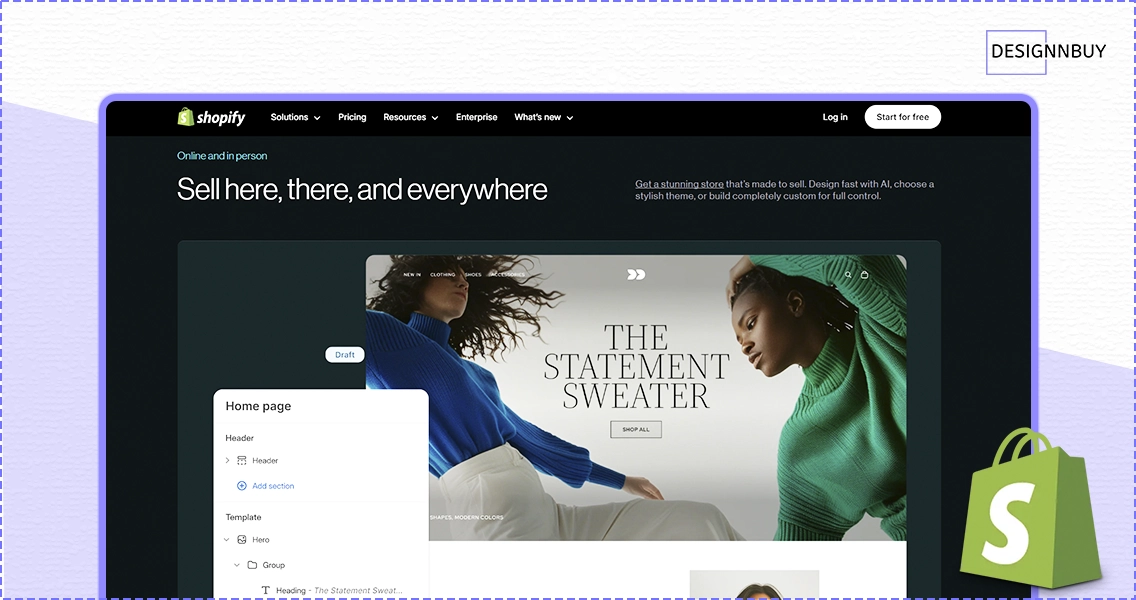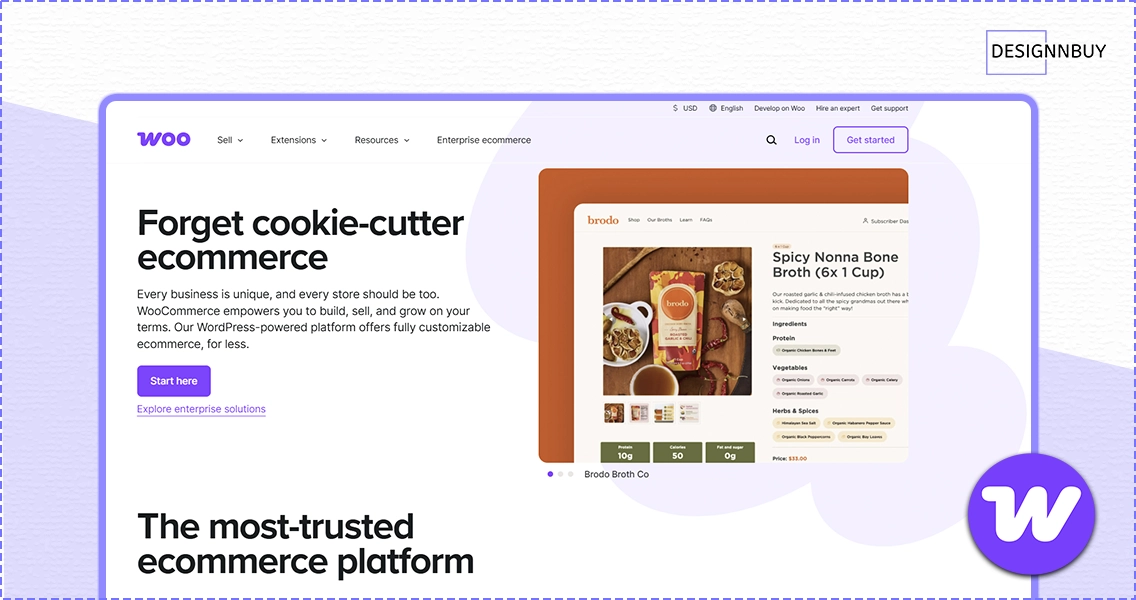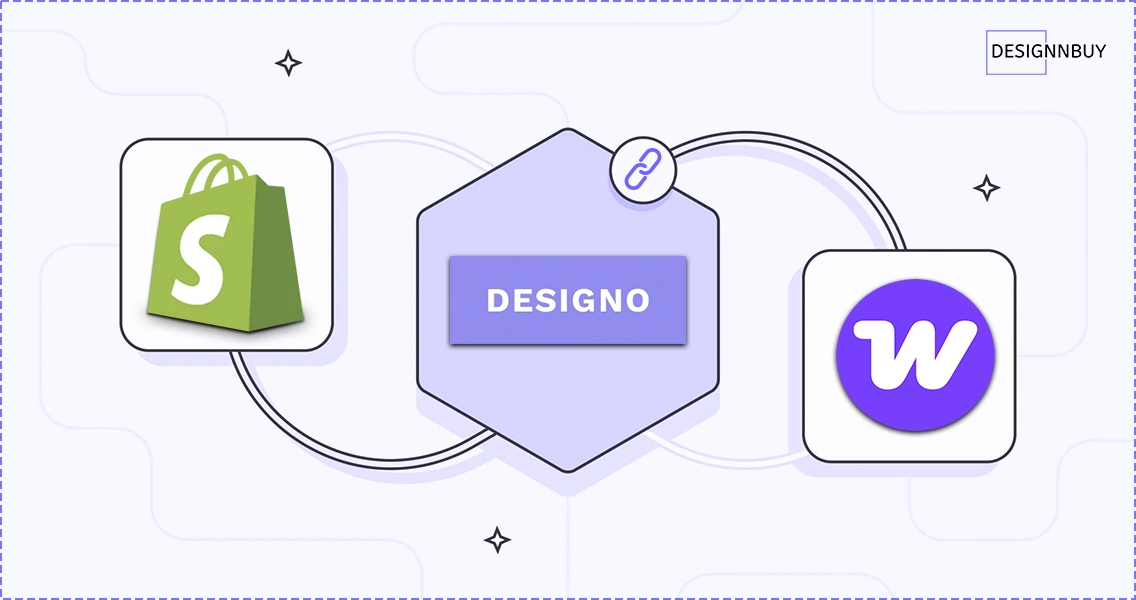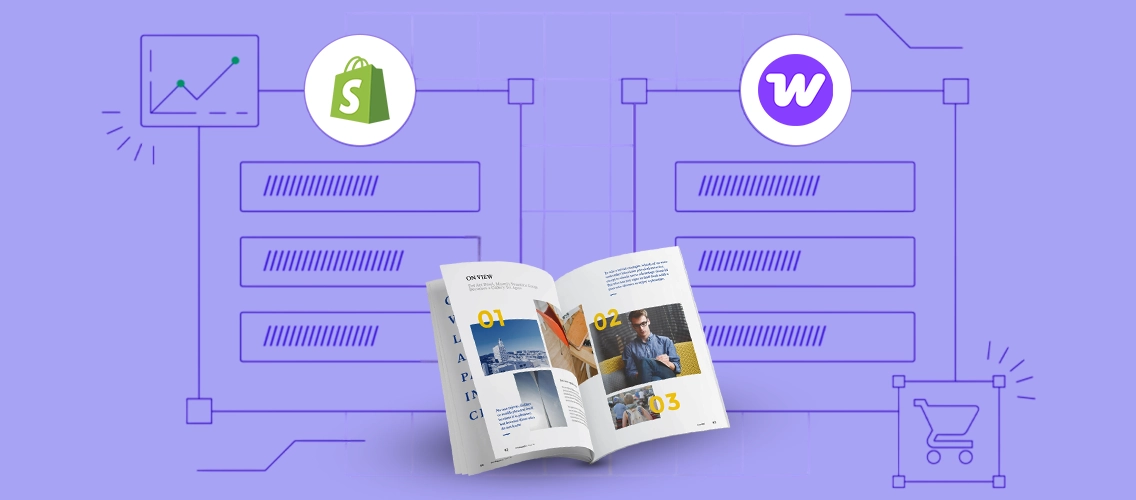As a print business owner, you’re ready to expand online with a web-to-print solution, but choosing between Shopify and WooCommerce feels daunting.
As you know, the web-to-print market is booming, and this market is expected to reach 2.65 billion by 2029. Therefore, picking the right platform plays a very important role in your online print business.
Both Shopify and WooCommerce have the power to make a print-friendly web-to-print storefront, but the approach of both platforms is different.
In this blog, we’ll do a simplified Shopify vs WooCommerce comparison from the perspective of a print business owner. We’ll highlight the platform fits, pricing, and its flexibility for the custom products.
So let’s get started.
Table of Contents
Quick Overview: Shopify vs WooCommerce
As we all know, Shopify and WooCommerce are one of the most popular ecommerce platforms on which millions of online eCommerce stores are built.
According to Mobicloud, Shopify has around 26% market share, whereas WooCommerce has ~20% globally. Both platforms serve different needs, and each one has its edge in different aspects.
Let’s break down these two ecommerce platforms and see what they offer at a foundational level.
What is Shopify?

Shopify is a hosted ecommerce platform that allows you to build, manage, and grow your online print store without worrying about hosting, security, or backend infrastructure.
It’s a subscription-based software where everything is managed for you, perfect for print businesses who want to get started quickly with minimal technical work.
You can pick a theme, customize your store visually, add products, and start selling.
All through a clean, intuitive dashboard. Shopify also handles things like SSL certificates, server uptime, and updates.
What is WooCommerce?

WooCommerce on the other hand, is an open-source ecommerce plugin built for WordPress. It turns any WordPress website into a fully functional online store.
Hence, with WooCommerce, you’re responsible for setting up your hosting, installing WordPress, and configuring the store environment.
This hands-on approach takes more work, but it also gives you far more control. You can customize everything, from the product page layout to the checkout flow, so it perfectly matches the way your printing business operates.
It’s a great option if you already have a development team or access to someone with solid WordPress experience, as they can unlock WooCommerce’s full flexibility.
How does Each Platform support eCommerce at a High Level?
| eCommerce Capability | Shopify | WooCommerce |
|---|---|---|
| Store Setup & Launch | Quick and guided onboarding; store ready in hours | Requires separate hosting, WordPress setup, and plugin configuration |
| Product Management | Intuitive UI for adding/editing products; supports variants and digital files | Fully flexible product creation with plugin support for advanced variations |
| Payment Gateways | 100+ payment gateways built-in (Shopify Payments, Stripe, etc.) | Supports all major gateways via plugins; some need manual setup |
| Shipping & Tax Calculation | Automated shipping and tax settings based on location | Manual setup or via third-party plugins |
| Sales Channels | Integrated with Facebook, Instagram, Amazon, Google | Requires plugins or third-party tools to connect sales channels |
| Mobile Optimization | Mobile-ready themes by default | Depends on theme; manual optimization may be needed |
| App/Plugins | Rich app store with vetted ecommerce tools, and Shopify product configurator | Extensive plugin library; more variety like WooCommerce product configurator |
| Inventory & Order Management | Built-in inventory tracking and order alerts | Depends on plugins; features vary by choice |
| Security & PCI Compliance | Fully managed by Shopify (SSL, PCI-DSS included) | You’re responsible for implementing SSL and security settings |
| Analytics & Reporting | Built-in ecommerce analytics with sales reports | Basic stats in dashboard; advanced tracking requires plugins or GA setup |
Shopify vs WooCommerce: Key Criteria for Print Businesses
To help you choose the right platform, we compare Shopify and WooCommerce across 8 criteria critical for print shops in 2025:
1. Pricing
Both these platforms have different pricing plans. Shopify offers a straightforward monthly plan, whereas WooCommerce is an open-source plugin, but hosting it will incur separate costs.
Let’s compare each plan through a table.
| Feature / Cost Item | Shopify | WooCommerce |
|---|---|---|
| Base Pricing | Basic: ~$19/month (yearly billing)Shopify: ~$49/monthAdvanced: ~$299/month | Free to use |
| Hosting | Included in all plans | $10–$50/month (depends on quality & speed) |
| SSL & Security | Included | Often included with hosting (check provider) |
| Domain | Not included | ~$14/year |
| Transaction Fees (Shopify Payments) | ~2.9% + 30¢ per order on Basic plan | Depends on payment gateway chosen |
| Extra Fees (if using other payment gateways) | 2% on Basic plan, drops to 0.5% on Advanced | No extra fee from WooCommerce itself |
2. Ease of Use
While growing your business online, the most important factor while choosing a platform is the ease of use. As you need to keep the process smooth.
Shopify:
Shopify is a fully hosted platform, so everything from hosting to security is handled for you. Its drag-and-drop functionality and pre-designed templates make it quick and easy to set up a store without any coding.
Let’s say you’re running a banner printing business in which you have seasonal campaigns. In this case, you need a platform in which you can launch quickly and start selling without worrying about technical setup.
Therefore, using Shopify, you will get a seamless experience.
WooCommerce:
On the other hand, if we talk about WooCommerce, it is an open-source WordPress plugin.
Here, you’re in charge of hosting, security, and updates. This brings freedom and flexibility, but at the same time, you need technical knowledge or a team for the setup.
Here, in your banner printing business with seasonal campaigns on WooCommerce, you’ll have complete control over the store’s design and functionality, but before launching, you’ll need to arrange hosting, install WordPress, configure WooCommerce, and manage security updates yourself.
Verdict:
- For a fast, hassle-free launch, Shopify is the better choice.
- For complete flexibility and customization, WooCommerce takes the lead.
3. Page Speed
Shopify is fast right out of the box, with store pages loading in about 0.31 seconds and checkout pages in around 0.22 seconds. Hosting, caching, and CDNs are all handled for you, so you get consistently smooth performance without needing a tech team.
WooCommerce speeds vary depending on your setup. With good hosting, caching, and optimization, it can match Shopify’s performance, but too many heavy plugins or poor hosting can slow both your store and admin area significantly.
| Feature / Factor | Shopify | WooCommerce |
|---|---|---|
| Average Store Page Load Time | Can load in ~0.31 seconds (varies by theme, apps, and location) | Can load in ~0.77 seconds with good hosting and setup |
| Checkout Page Load Time | Around 0.22 seconds on an optimized Shopify setup | Around 1.32 seconds on a well-optimized setup |
| Hosting & Optimization | Fully managed and speed-optimized by Shopify | Dependent on hosting quality, caching, and CDN |
| Risk of Slowdowns | Low, unless using heavy apps or custom scripts | Higher, especially with too many heavy plugins or poor hosting |
| Tech Effort Needed | None | Moderate to high for best speeds |
4. Design & Templates
Templates and design layouts are a key part of creating a visually appealing and consistent online store.
In this section, we’ll compare how Shopify and WooCommerce approach design and templates, helping you understand which platform aligns better with your store’s needs.
Shopify:
Shopify offers over 160 themes, all mobile-responsive and easy to edit with a drag-and-drop builder, no coding required.
It makes it simple to manage templates and design layouts. Its built-in themes and apps allow you to quickly set up pre-designed layouts that you can select, customize, and preview directly on product pages.
WooCommerce:
WooCommerce offers more flexibility and control over templates. You can create multi-layered designs, assign templates to specific products or categories, and define custom rules for how templates are applied.
Verdict
- If you want a stylish web to print storefront you can launch quickly, Shopify is the way to go.
- If you want full creative control and the ability to build a completely unique brand experience, WooCommerce is the better choice.
▶️ Explore our Web to Print Store Front and Book a Demo to see it in action.
5. Apps & Plugins
An online store without apps and plugins is like a tool without a workshop. It helps you improve the overall experience of your eCommerce store.
Shopify:
Shopify has its own App Sore, where every app is tested and built to work smoothly with the platform.
This means you can add features, like a product personalization software, shipping integration, or workflow automation, without worrying about compatibility issues.
This means that setup is quick, easy to install, and configure in Shopify
WooCommerce:
WooCommerce connects with WordPress, giving you access to a huge variety of plugins.
You can find one for almost anything, real-time design previews, custom packaging calculators, WooCommerce product customizer, or advanced order management.
Many are free or require just a one-time payment, which can be easier on the budget in the long run.
However, not every plugin is as polished or regularly updated. Sometimes they need a bit of technical help to keep everything running smoothly. On the plus side, WooCommerce gives you more flexibility to tailor your store exactly how you want it.
Verdict
- If you want a simple, reliable setup where your tools just work, Shopify’s apps are a safe choice.
- If you’d rather have more control and potentially lower long-term costs, WooCommerce’s plugins give you that freedom.
6. Inventory Management
Managing inventory is a big part of running a smooth print business, especially when you’re juggling multiple product types, locations, or seasonal campaigns.
Here’s how Shopify and WooCommerce handle it.
Shopify
Shopify comes with a built-in inventory management system that works right out of the box.
You can easily track stock levels, set up low-stock alerts, and manage products across multiple locations. If you sell both online and in-person, say through a retail store or trade events, Shopify syncs inventory in real time so you don’t oversell.
For web-to-print businesses, this means you can keep track of printed stock items like ready-made packaging, while also managing raw materials for custom orders.
If you need more advanced features like batch tracking or supplier management, Shopify’s App Store has add-ons to handle it.
WooCommerce
WooCommerce’s core plugin includes basic inventory management like tracking stock, marking items as in/out of stock, and managing backorders.
Furthermore, it works well for smaller operations, but if you need advanced controls like tracking raw materials, syncing multiple warehouses, or managing variable product components, you’ll likely need additional plugins.
The good news is that many of these inventory plugins are one-time purchases, not monthly subscriptions, which can save money over time. However, integrating them with other systems (like your MIS or supplier databases) might require some technical setup.
Verdict
- If you want a ready-to-use, simple inventory system that grows with your store, Shopify is the easier choice.
- If you prefer more flexibility, custom features, and potentially lower long-term costs, WooCommerce can deliver.
7. SEO & Blogs
Whether you just want quick, simple visibility or you’re planning to run a content-rich blog strategy, Shopify and WooCommerce take very different approaches to SEO and blogging.
Shopify
Shopify gives you a solid SEO foundation right from the start. It automatically handles key technical details like sitemaps, canonical tags, structured data, and mobile-friendly templates, all of which help your store get noticed smoothly
Furthermore, You can also easily edit meta titles, descriptions, URLs, and image alt text for each product or page
Shopify includes a built-in blog too, it’s simple and integrated, so you don’t need a separate platform. If you want more advanced features or templates, there are apps to help, but they typically add extra cost
WooCommerce
Since WooCommerce runs on WordPress, you get the full power and flexibility of one of the world’s strongest blogging platforms. You can tailor everything, from blog design to SEO details, using top-notch plugins like Yoast SEO or Rank Match.
That means you can deeply optimize headlines, metadata, sitemaps, and content structure for search engines, giving you granular control over how your store and blog perform.
Verdict
- If you’re looking for simplicity and everything “just works,” Shopify handles SEO basics and blogging with little setup needed.
- If you want to create rich, optimized blog content, say, in-depth guides on managing print workflows or showcasing customer case studies. WooCommerce gives you unparalleled flexibility and control.
8. Payment Gateways
Let’s check out the range of payment options and their approach to fees that these platforms are offering.
Shopify
Shopify supports over 100 payment gateways worldwide, including Shopify Payments (its own system) and popular options like PayPal, Stripe, and Authorize.net.
Using Shopify Payments means lower transaction fees and faster payouts, but if you use a third-party gateway, Shopify charges up to an extra 2% per transaction (reduced or waived on higher plans).
For web-to-print businesses that serve multiple countries, Shopify’s built-in multi-currency and localized payment options are a big plus. It also offers built-in fraud analysis, which is reassuring when handling high-value custom print orders.
WooCommerce
WooCommerce doesn’t charge extra fees beyond what the payment provider takes, which can save money, especially on high-volume orders.
It supports all major gateways like PayPal, Stripe, Square, and Authorize.net, plus regional options through plugins.
Because WooCommerce runs on WordPress, adding a payment method is as simple as installing a plugin.
This means you can offer highly tailored checkout options, like deposits for large print orders or custom invoicing for repeat B2B clients.
However, setting up certain gateways may require more configuration compared to Shopify’s plug-and-play approach.
How does Designo’s integration work with Shopify and WooCommerce?

DesignO is a powerful web-to-print design tool that lets your customers personalize products right on your website.
But how it connects and works with Shopify and WooCommerce can impact your store’s setup and user experience.
DesignO – WooCommerce Product Configurator
If you’re looking for a WooCommerce product designer, then DesignO for WooCommerce is the perfect solution to add powerful web-to-print capabilities to your store.
Features:
- Layered design editor with real-time preview
- Flexible product linking
- Supports complex workflows and custom order metadata
- Deep integration with the WooCommerce order system
- Customizable editor layout and display options
DesignO – Shopify Product Customizer
If you’re looking for a web to print Shopify solution, then DesignO for Shopify is the perfect choice for your business.
Features:
- Real-time product personalization with layered design options
- Supports multiple product variants and SKUs
- Mobile-friendly editor embedded on product pages
- Automatic syncing of customized orders with Shopify backend
- Quick setup with minimal technical effort
Conclusion
With web-to-print essential for print businesses in 2025, Shopify and WooCommerce offer distinct solutions.
Shopify excels in simplicity and speed, ideal for print business owners prioritizing quick launches and reliability. WooCommerce shines with customization and cost savings, perfect for those needing tailored workflows.
Choose based on your team’s skills, budget, and goals, and consult a web-to-print expert for setup guidance.
By integrating tools like DesignNBuy’s DesignO, either platform can deliver a professional web-to-print experience.
Get Your Print Business Online Fast.
Pair Shopify or WooCommerce with our Web-to-Print software for a print-ready store.




